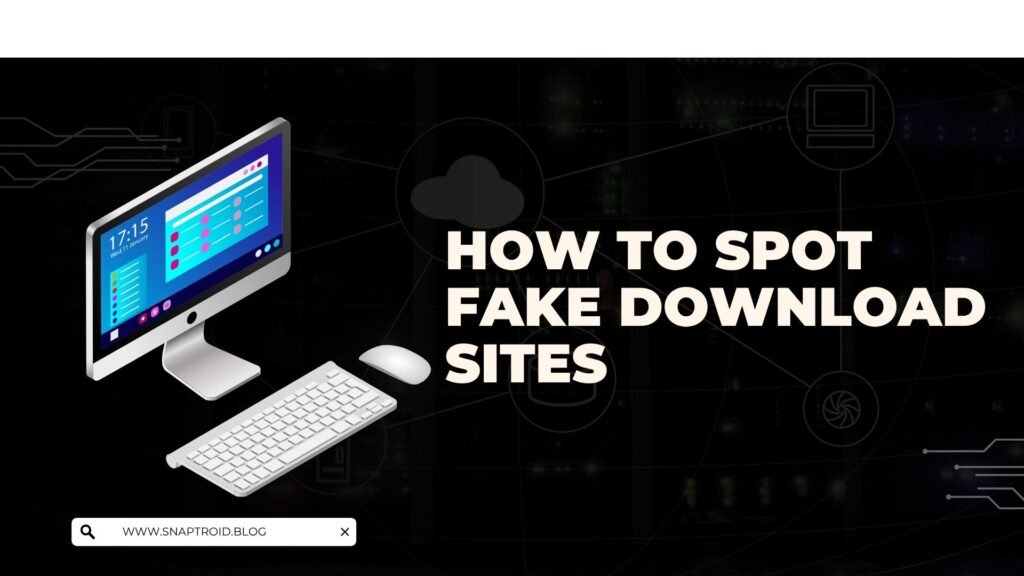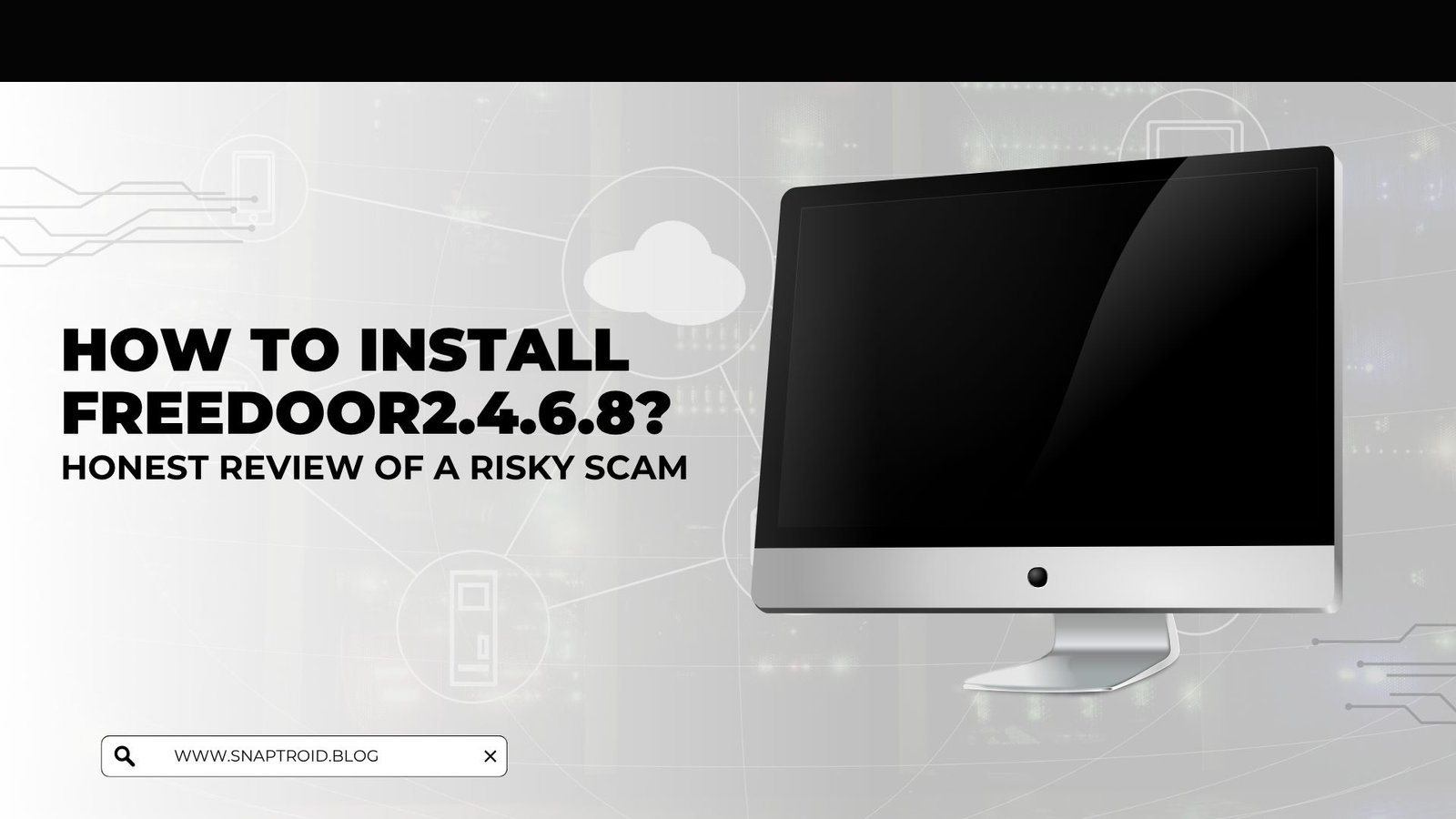Scams lurk online every day. Fake software can harm your computer or steal your data. Searching for “how to install freedoor2.4.6.8” leads to dangerous websites. I’m Ramona P. Woodmansee, an online safety expert. I research digital scams and social media risks. This guide shares download safety tips to protect your device. It explains why “freedoor2.4.6.8” is a scam. Follow these simple steps to stay safe.
Why “Freedoor2.4.6.8” Is a Scam
Searches for “how to install freedoor2.4.6.8” are risky. No real software uses this name. I’ve studied scams for years. This name is a trick to fool you. Scammers create fake programs to push harmful files. These files can damage your computer or steal your information.
The name “freedoor2.4.6.8” looks odd. Real software has clear names like “Google Chrome” or “VLC Player.” The version number 2.4.6.8 is also strange. Most software uses short versions like 2.4 or 3.0. Scammers use long numbers to seem real. Websites offering “freedoor2.4.6.8” often have pop-up ads or messy designs. These are clear signs of a scam.
Risks of Fake Downloads
Fake software poses real dangers. Knowing the risks is key to avoiding them. Downloading “freedoor2.4.6.8” or similar fakes can cause serious problems. Here are the main threats:
- Viruses make your computer slow or crash.
- Data theft takes your passwords or bank details.
- Ransomware locks your files until you pay money.
- Adware adds annoying ads to your browser.
- System damage stops your computer from working.
My work analyzing tools like Snaptroid shows these threats are common. Scammers target people who don’t check downloads. Staying careful keeps you safe.
How to Spot Fake Download Sites

Fake download sites are easy to spot once you know the signs. They trick users into downloading bad files. Searches for “how to install freedoor2.4.6.8” often lead to these sites. Here’s what to watch for.
Signs of a Shady Website
Bad websites have clear warning signs. Look for these clues to avoid scams.
- Too many ads or pop-ups cover the screen.
- Bad grammar or spelling mistakes appear in text.
- No contact info like an email or phone number.
- Strange web addresses, like random letters or numbers.
Real websites look professional. They have clear menus and secure addresses starting with “https://.” If a site feels wrong, leave it. My research on scam websites shows these signs catch most fakes.
Examples of Fake Sites
Some fake sites look real at first. For example, a site might claim to offer “freedoor2.4.6.8” with a big “Download Now” button. It may have fake reviews or logos to seem trustworthy. But small details give it away. The address might be something like “freedoor-download-xyz.com.” Real software like VLC Player uses videolan.org. Always check the website’s address and design.
How to Find Safe Software
Safe software comes from trusted sources. You can avoid scams like “how to install freedoor2.4.6.8” with these steps. I’ll explain each one clearly.
Use Official Websites
Every real software has an official website. For example, to get Firefox, visit mozilla.org. Use Google to search the software’s name. Look for websites ending in .com, .org, or .edu. These are usually safe. Good websites look clean and have contact details. Bad websites have ads or pop-ups. Avoid them to stay safe.
Try Trusted Platforms
Trusted platforms check software for safety. They’re safer than random websites. For Windows, use the Microsoft Store. It tests apps for viruses. For Mac or iPhone, try the Apple App Store. Linux users can use Ubuntu’s Software Center. These platforms reduce the risk of fake downloads. They’re great for beginners.
Read User Reviews
Reviews show if software is safe or useful. Check websites like CNET or TechRadar. They test software and share honest opinions. You can also look on Reddit or GitHub. People share their experiences there. If software has no reviews or bad feedback, don’t download it. My research on risky apps taught me to always check reviews.
Verify the Developer
Real software comes from known developers. For example, Adobe makes Photoshop. Microsoft makes Word. Visit the software’s website. Look for a “Team” or “About” page. Search the developer’s name online. If you can’t find details, it’s a warning sign. Trusted developers are easy to verify.
How to Install Software Safely
Once you find safe software, install it correctly. These steps work for any real program. They protect you from fakes like “freedoor2.4.6.8.”
Step 1: Download from a Trusted Source
Always download from the official website or a trusted platform. Never use random sites. Go to the software’s main page. Find the “Download” button. It’s usually easy to spot. Choose the version for your computer, like Windows or Mac. For example, to get VLC Player, visit videolan.org. Don’t trust sites offering “how to install freedoor2.4.6.8.” They’re scams.
Step 2: Verify the File
Before opening the file, check it. Look at the file name. It should match the software. For VLC, it might be “vlc-3.0.20-win64.exe.” If the name is odd, don’t open it. Check the file size. Real software is usually over 10MB. Tiny files are often fake. Scan the file with antivirus software. Windows Defender is free and works well. It catches dangerous files.
Step 3: Customize the Installation
Double-click the file to start the installer. A window will open with steps. Read each screen carefully. Some installers add extra software, like browser toolbars. This is called adware, which adds annoying ads to your browser. Look for checkboxes like “Install Extra App.” Uncheck them. Choose “Custom Install” if you see it. This lets you control what’s added.
Step 4: Test for Issues
After installing, open the software. Try it out. Does it look professional? Does it work smoothly? Real software runs well. If it crashes or shows ads, something’s wrong. Go to your computer’s settings and uninstall it. Testing catches problems early. My work with scam tools shows this step is key.
What to Do If You Searched “How to Install Freedoor2.4.6.8”
If you searched “how to install freedoor2.4.6.8,” you might have seen risky websites. Don’t worry. You can stay safe with these steps.
Stop Downloading
Close any strange website. Don’t click “Download Now” buttons. Pop-up ads are dangerous. If you started a download, go to your browser’s download list. Delete the file before it finishes. This stops fake software from getting on your computer.
Scan Your Computer
If you downloaded a file, scan your device. Use antivirus software like Windows Defender or Malwarebytes. Run a full scan. It checks every file. If it finds something bad, delete it. Restart your computer to be sure. This catches most threats.
Change Passwords
Fake software can steal passwords. Update yours to be safe. Make new passwords with letters, numbers, and symbols. Don’t reuse passwords. Turn on two-factor authentication (2FA). This adds a second step to logging in, like entering a code sent to your phone. It stops hackers even if they have your password.
Avoid Shady Websites
Bad websites trick you with fake downloads. They have too many ads. They use bad grammar. They lack contact info. Good websites are clean and clear. My research shows these signs help you spot scams.
Tools to Avoid Malware from Fake Programs
Some tools protect your computer. They stop fake software like “freedoor2.4.6.8.” I’ve tested these in my work. They’re easy to use.
Antivirus Software
Antivirus programs catch bad files. Windows Defender is free and comes with Windows. It’s simple and effective. Malwarebytes finds adware and junk. Bitdefender is strong for advanced users. Install one and keep it updated. It warns you about fake downloads.
Browser Extensions
Extensions block risky websites. uBlock Origin stops ads and pop-ups. HTTPS Everywhere forces secure connections. ClearURLs removes tracking links. These are free and easy to add. They make browsing safer.
Password Managers
Password managers create strong passwords. LastPass stores them securely. 1Password is simple and safe. Bitwarden is free and open-source. You only need to remember one password. This keeps hackers out.
Why Trust This Guide
I’m Ramona P. Woodmansee. I’ve studied online safety for years. I write about digital scams and social media risks. My articles appear in trusted cybersecurity blogs. I’ve analyzed fake tools like Snaptroid and scams like “freedoor2.4.6.8.” This guide uses my research to keep you safe. It’s based on facts and experience. For more tips, visit CISA’s Cybersecurity Best Practices.
My work protects users from online dangers. I research threats and share clear advice. This article helps you avoid fake software. You can trust it to guide you.
Frequently Asked Questions (FAQs)
People ask about software safety often. Here are clear answers to common questions. They’re based on my research.
Is “freedoor2.4.6.8” a real program?
No, it’s not real. I searched and found no legitimate software. Searches for “how to install freedoor2.4.6.8” lead to scam websites. These sites push fake files that harm your computer. Stick to trusted sources like official websites.
How do I spot a fake download site?
Check the website’s address. It should start with “https://” for security. Look for contact info, like an email. Safe websites look clean. Bad ones have ads, pop-ups, or bad grammar. Leave if something feels wrong.
What if I downloaded a fake file?
Don’t open it. Scan your computer with antivirus software like Windows Defender. Delete the file if it’s dangerous. Change your passwords. Watch for slow performance or ads. Get tech help if problems stay.
Is free software safe to use?
Yes, if it’s from a trusted source. VLC Player and GIMP are safe and free. Download from official websites or GitHub. Avoid random sites. Check reviews and the developer’s reputation first.
What is ransomware, and why is it bad?
Ransomware locks your files. You might need to pay to unlock them. It comes from fake software like “freedoor2.4.6.8.” Use antivirus software and avoid fake downloads to stay safe.
How does two-factor authentication help?
Two-factor authentication (2FA) adds a second login step. For example, you enter a code sent to your phone. It stops hackers, even if they have your password. Turn it on for your accounts.
Take Action Today
Staying safe is easy with these steps. Protect your computer from fake software like “freedoor2.4.6.8.” Start now:
- Download only from official websites.
- Scan files with antivirus software.
- Watch for scam signs like odd names.
- Use strong passwords and 2FA.
- Share these download safety tips.
My research shows careful habits stop scams. You don’t need to be a tech expert. Follow these steps to keep your computer safe.
Disclaimer
This article is for educational and informational purposes only. The author, Ramona P. Woodmansee, aims to provide accurate and relevant content but cannot guarantee the security or reliability of any third-party websites or tools referenced. Use caution when downloading software and seek advice from a qualified IT professional if you suspect malware or security issues. The author does not endorse or promote fraudulent programs, such as “freedoor2.4.6.8.” This article seeks to promote online safety and awareness.
Explore More
Ultimate Guide to Give Away Look Whatmomfound 2025: Safe and Legit Tips
